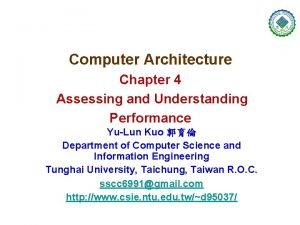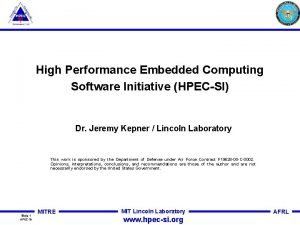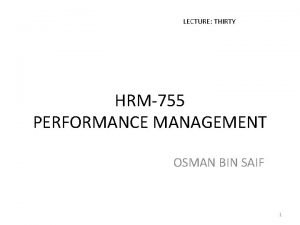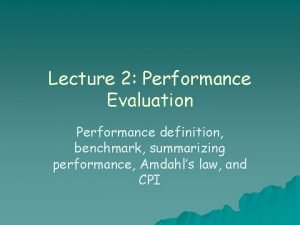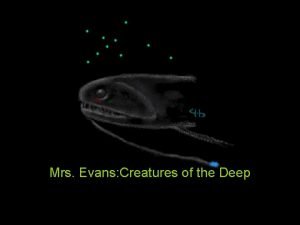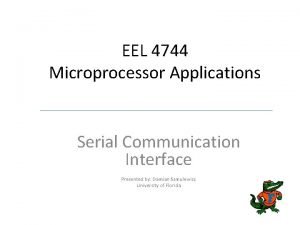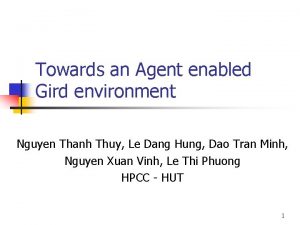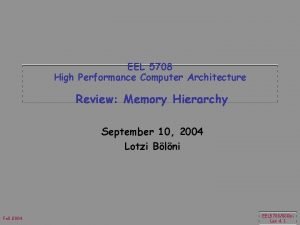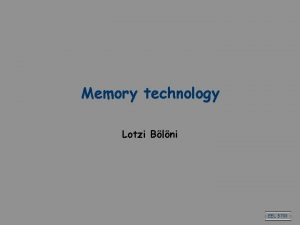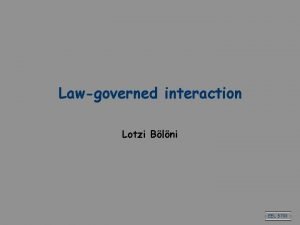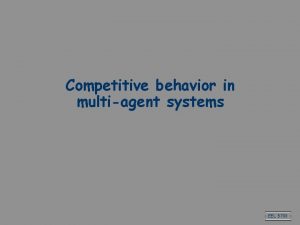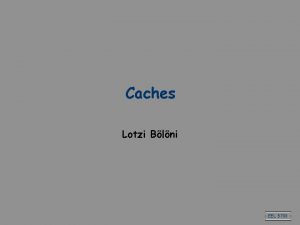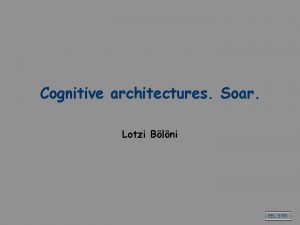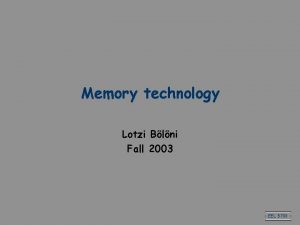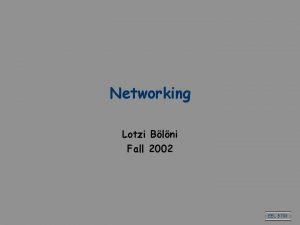EEL 5708 High Performance Computer Architecture Lecture 2
















- Slides: 16

EEL 5708 High Performance Computer Architecture Lecture 2 Introduction: the big picture Lotzi Bölöni Fall 2005 Fall 2004 EEL 5708/Bölöni Lec 2. 1

Acknowledgements • All the lecture slides were adopted from the slides of David Patterson (1998, 2001) and David E. Culler (2001), Copyright 19982002, University of California Berkeley Fall 2004 EEL 5708/Bölöni Lec 2. 2

Research Paper Reading • As graduate students, you are now researchers. • Most information of importance to you will be in research papers. • Ability to rapidly scan and understand research papers is key to your success. • So: about 1 paper / week in this course – Quick 1 paragraph summaries will be due as homework – Important supplement to book. – Will discuss papers in class • Links to the papers will be posted on the course webpage Fall 2004 EEL 5708/Bölöni Lec 2. 3

First reading • G. Amdahl, G. A. Blaauw, F. P. Brooks, Jr – Architecture of the IBM System 360 • Link from the course website • A good paper to improve your skills in reading papers. Fall 2004 EEL 5708/Bölöni Lec 2. 4

Why take EEL 5708? • To design the next great instruction set? . . . well. . . – instruction set architecture has largely converged – especially in the desktop / server / laptop space – dictated by powerful market forces • Tremendous organizational innovation relative to established ISA abstractions • Many new instruction sets or equivalent – embedded space, controllers, specialized devices, . . . • Design, analysis, implementation concepts vital to all aspects of EE & CS – systems, PL, theory, circuit design, VLSI, comm. • Equip you with an intellectual toolbox for dealing with a host of systems design challenges Fall 2004 EEL 5708/Bölöni Lec 2. 5

Example Hot Developments ca. 2002 • Manipulating the instruction set abstraction – – – Itanium: translate ISA 64 -> micro-op sequences Pentium IV - hyperthreading Transmeta: continuous dynamic translation of IA 32 Tensilica: synthesize the ISA from the application reconfigurable HW • Virtualization – vmware: emulate full virtual machine – JIT: compile to abstract virtual machine, dynamically compile to host • Parallelism – wide issue, dynamic instruction scheduling, EPIC – multithreading (SMT) – chip multiprocessors • Communication – network processors, network interfaces • Exotic explorations – nanotechnology, quantum computing Fall 2004 EEL 5708/Bölöni Lec 2. 6

1988 Computer Food Chain Mainframe Supercomputer Minisupercomputer Work- PC Ministation computer Massively Parallel Processors Fall 2004 EEL 5708/Bölöni Lec 2. 7

Massively Parallel Processors Minisupercomputer Minicomputer 1998 Computer Food Chain Mainframe Server Supercomputer Fall 2004 Work- PC station Now who is eating whom? EEL 5708/Bölöni Lec 2. 8

Why Such Change in 10 years? • Performance – Technology Advances » CMOS VLSI dominates older technologies (TTL, ECL) in cost AND performance – Computer architecture advances improves low-end » RISC, superscalar, RAID, … • Price: Lower costs due to … – Simpler development » CMOS VLSI: smaller systems, fewer components – Higher volumes » CMOS VLSI : same dev. cost 10, 000 vs. 10, 000 units – Lower margins by class of computer, due to fewer services • Function – Rise of networking/local interconnection technology Fall 2004 EEL 5708/Bölöni Lec 2. 9

Technology Trends: Microprocessor Capacity “Graduation Window” Moore’s Law ATI Radeon 9700: 110 million (graphics processor) Pentium D Smithfield: 230 m Pentium 4: 55 million Athlon XP: 37. 5 million Alpha 21264: 15 million Pentium Pro: 5. 5 million Power. PC 620: 6. 9 million Alpha 21164: 9. 3 million Sparc Ultra: 5. 2 million CMOS improvements: • Die size: 2 X every 3 yrs • Line width: halve / 7 yrs Fall 2004 EEL 5708/Bölöni Lec 2. 10

Processor Performance Trends 1000 Supercomputers 100 Mainframes 10 Minicomputers Microprocessors 1 0. 1 1965 1970 1975 1980 1985 1990 1995 2000 Year Fall 2004 EEL 5708/Bölöni Lec 2. 11

Memory Capacity (Single Chip DRAM) year 1980 1983 1986 1989 1992 1996 Fall 2004 size(Mb) cyc time 0. 0625 250 ns 0. 25 220 ns 1 190 ns 4 165 ns 16 145 ns 64 EEL 5708/Bölöni 120 ns Lec 2. 12

Technology Trends (Summary) Fall 2004 Capacity Speed (latency) Logic 2 x in 3 years DRAM 4 x in 3 years 2 x in 10 years Disk 4 x in 3 years 2 x in 10 years EEL 5708/Bölöni Lec 2. 13

Technology Trends in the 1990 s • • • Clock Rate: ~30% per year Transistor Density: ~35% Chip Area: ~15% Transistors per chip: ~55% Total Performance Capability: ~100% • plus 16 x dram density, 32 x disk density Fall 2004 EEL 5708/Bölöni Lec 2. 14

Newest trends (Fall 2005) • Moore’s law is probably over. • Future VLSI improvements will probably be linear (as opposed to exponential). • Multi-core chips will be the new standard, from as early as 2006. • Parallel programs will become much more important, even for mainstream. • And many developments which we can not foresee at this moment. Fall 2004 EEL 5708/Bölöni Lec 2. 15

What is “Computer Architecture”? Application Operating System Compiler Firmware Instr. Set Proc. I/O system Instruction Set Architecture Datapath & Control Digital Design Circuit Design Layout • Coordination of many levels of abstraction • Under a rapidly changing set of forces • Design, Measurement, and Evaluation Fall 2004 EEL 5708/Bölöni Lec 2. 16
 Architecture lecture notes
Architecture lecture notes Isa definition computer
Isa definition computer 01:640:244 lecture notes - lecture 15: plat, idah, farad
01:640:244 lecture notes - lecture 15: plat, idah, farad Computer architecture performance evaluation methods
Computer architecture performance evaluation methods Response time in computer architecture
Response time in computer architecture High performance embedded computing
High performance embedded computing Bus architecture in computer organization
Bus architecture in computer organization Difference between architecture and organisation
Difference between architecture and organisation Interrupt cycle flow chart
Interrupt cycle flow chart Performance management lecture
Performance management lecture Lecture performance definition
Lecture performance definition The woman in black chapter 2
The woman in black chapter 2 Gulper eel lifespan
Gulper eel lifespan Deep-sea shrimp
Deep-sea shrimp Eel4744
Eel4744 Nguyen
Nguyen Rahvusvahelised suhted
Rahvusvahelised suhted




